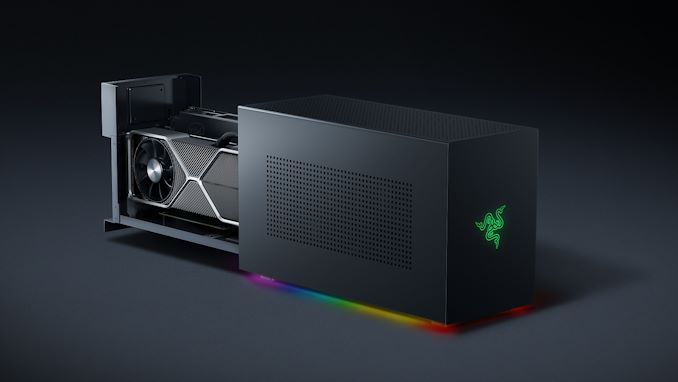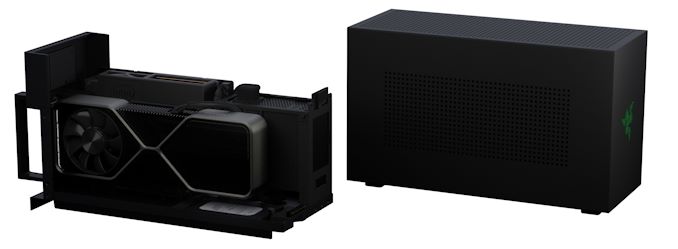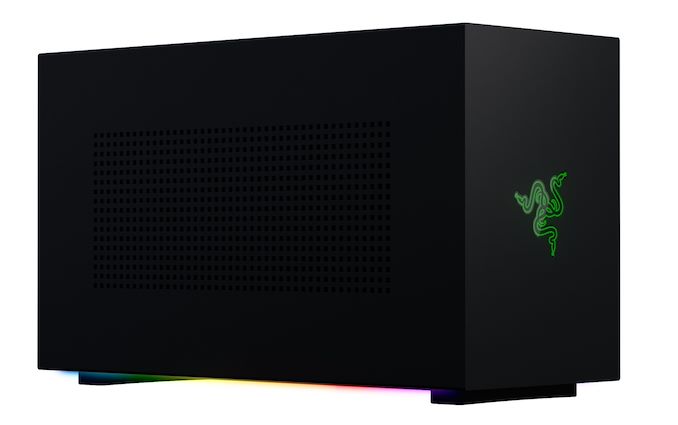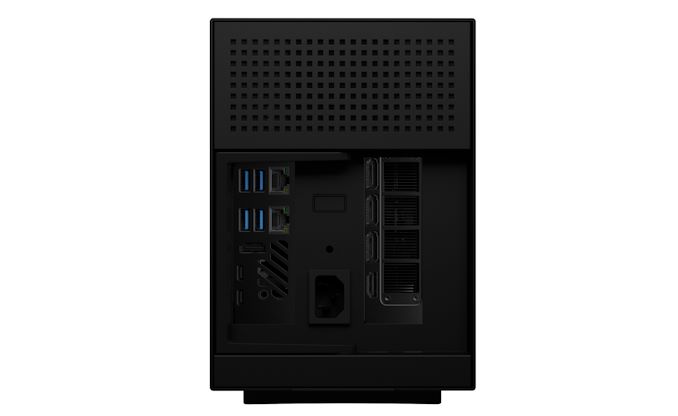Razer's First Modular PC, The Tomahawk: A Fully Custom NUC 9 Extreme
by Gavin Bonshor on December 3, 2020 10:00 PM EST
Razer, a company that styles itself as 'by gamers, for gamers', has today unveiled its latest product, a modular NUC dubbed the Tomahawk. Available as both a barebones package and a high-tier gaming solution, the Razer Tomahawk looks to offer a 'cutting edge' mixture of functionality, performance, and graphics card compatibility, all within a NUC inspired chassis. Some of the key specifications include an Intel 9th generation Core i9 processor, with a 512 GB PCIe 3.0 x4 SSD, 2 TB of HDD storage, 16 GB of DDR4-2667 memory, and an optional RTX 3080.
The term NUC (Next Unit of Computing) gets thrown around a lot when it comes to super small form factor desktop computers, even when NUC is technically an Intel term. Going all the way back to 2014, when Razer's CEO unveiled a conceptual design for a modular PC dubbed 'Project Christine,' Intel looked to have taken the idea a step forward with what it called Element. We've seen many Intel NUCs hit the market this year, including the NUC 9 Extreme (NUC9i9QNX), which we reviewed back in April. Razer being Razer has gone one step further on this idea and created its own version of the NUC, with the Razer Tomahawk.
What sets the Razer Tomahawk apart from other NUCs on the market is its full-scale capability to install a full-sized graphics card with a maximum length of up to 320 mm, with a maximum height of 140 mm. This moves away from common small form factor systems, which generally have to opt for smaller alternatives such as the NVIDIA GTX 1650. The Razer Tomahawk features a tool-less sled that allows users access to the system, which could be to upgrade the storage or even install a new graphics card.
While this is a 'modular' system, it is essentially a PCIe backplane with two PCIe slots. In one slot goes the graphics card, and in the other is 'the rest of the PC'. That rest of the PC includes a 45 W overclockable mobile processor (unupgradable), memory (upgradeable), and storage (upgradeable). Despite there being a barebones option, Razer pre-populates all models with a 512 GB NVMe SSD, a 2 TB HDD, and 16 GB of DDR4-2667 (Razer doesn't say if this is 1x16 or 2x8). On both models there is a spare M.2 NVMe slot, and the barebones simply lacks the discrete GPU, but the integrated GPU can be used if there is not a discrete GPU present.
It wouldn't be a Razer product if it didn't have RGB LEDs. It includes an illuminated green Razer logo on the front panel, with addressable RGB LEDs on the underneath of the chassis to provide a bit of flair. Focusing on the size, the Tomahawk chassis is 19.23 x 24.15 x 1.60 inches (HxWxD), so it is svelte, and it also weighs in at 16.2 lbs. In terms of volume, the chassis itself is 10 L, which is big enough to fit all of the components in when designed efficiently.
| Razer Tomahawk Gaming NUC Desktop | ||
| Component | Barebones | Full System |
| CPU | Intel Core i9-9980HK (Coffee Lake) 8 Core / 16 Thread 2.4 GHz Base 5.0 GHz Turbo 45 W TDP |
|
| GPU | Optional (Intel UHD 630 if none) |
NVIDIA RTX 3080 Founders Edition 1.71 GHz Boost 10 GB GDDR6X |
| Memory | 16 GB DDR4-2667 | |
| Storage | 512 GB NVMe PCIe 3.0 x4 2 TB 5400 RPM Hard Drive 1 x M.2 PCIe 3.0 x4 (open) |
|
| Networking | 2 x Gigabit LAN | |
| Wireless | Intel AX200 (Wi-Fi 6/BT 5.0) | |
| I/O | 2 x USB 3.2 G2 Type-C (Thunderbolt 3) 4 x USB 3.2 G2 Type-A 1 x 3.5 mm audio jack 2 x Gigabit RJ45 1 x HDMI 2.0a |
|
| Audio | 3.5 mm TOSLINK combo port | |
| Power | 750 W SFX Power Supply | |
| Dimensions | 19.23 x 24.15 x 1.60 inches (HxWxD) | |
| Weight | 16.2 lb/7.35 kg | 18.3 lb/8.3 kg |
| Pricing | $2400 | $3200 |
| Availability | ??? | |
Given the nature of the hardware installed, Razer has opted to cool the processor actively and includes two top-mounted 120 mm chassis fans, with ventilation on both side panels and the top panel. Powering the Tomahawk is a preinstalled 750W SFX power supply, although Razer hasn't specified the exact model.
In terms of connectivity, the Tomahawk includes four USB 3.2 G2 Type-A ports, with two Thunderbolt 3 USB Type-C ports, and a single HDMI 2.0a video output. Users opting for the full package, including an NVIDIA RTX 3080 Founders Edition graphics card, adds three DisplayPort 1.4b and a single HDMI 2.1 video output. Networking includes two Gigabit Ethernet ports driven by unspecified controllers, while there's also an Intel AX200 Wi-Fi 6 interface, which includes support for BT 5.0 devices. Nestled in between the motherboard and graphics, I/O is a single 3.5mm audio jack that can accommodate speakers or act as a TOSLINK combo port.
A few possible use case scenarios for those with bottomless pockets or shallow desks could find this an ideal system to take to LAN, to and from work, or even for an on the go content creator. While Razer did unveil its own chassis called the Tomahawk Elite back at CES 2019, the Tomahawk Gaming System is a higher-grade and RGB infused version of Intel's NUC 9 Extreme.
As previously mentioned, the Razer Tomahawk gaming desktop will be available as barebones without a graphics card for a base price of $2400, while the full model equipped with an RTX 3080 Founders Edition will cost $3200. It's not a cheap outlay, especially for an Intel system featuring an RTX 3080, but the latter hasn't been easy to source of late.
Related Reading
- ASRock Brings Zen 2 NUC: 4X4 BOX-4800U Renoir Mini-PC Reviewed
- Intel Ghost Canyon NUC9i9QNX Review: NUC 9 Extreme Realizes the SFF Dream
- Kontron Releases KBox B-202 CFL Mini-ITX PC: SFF Desktop For Commercial Use
- CES 2020: ZOTAC's Inspire Studio SFF PCs for Creators w / 8-Core CPU and GeForce RTX
- Razer's Project Christine: A Modular PC Prototype





_thumb.jpg)
_575px_thumb.jpg)
_thumb.jpg)
_575px_thumb.jpg)
_thumb.jpg)
_575px_thumb.jpg)








61 Comments
View All Comments
damianrobertjones - Friday, December 4, 2020 - link
Next Unit of Computing... Seems like a term that can be applied to whatever they see fit.If it were 'Small Ass Computer', SAC, then yeah, I'd get your point.
sorten - Friday, December 4, 2020 - link
Yeah, so maybe the term never had any meaning. But I consider Intel's many NUCs as prior art, and those all had a similar, very small form factor. Certainly didn't have dedicated GPUs.Deicidium369 - Friday, December 11, 2020 - link
Agreed - to me even the Skull Canyon form factor isn't really what I consider to be NUC.Alistair - Thursday, December 3, 2020 - link
I just want an Xbox Series X with Windows. Would bebetter but $1000 USD instead (assuming double the Xbox price would be ok).Alistair - Thursday, December 3, 2020 - link
Call it the Surface MINIPC.Silver5urfer - Friday, December 4, 2020 - link
Look up at the SFF market, so many people build machines which are better than a console. A PC is always superior to Console and will be. Console is already outdated and non upgradeable. The perf is maxed out at sub 3700X, due to TBP and Clocks. And GPU is lower than a 3060Ti, it's a dead end.SFF PC, gets a 5600X and a 6700XT. Next year drop in ugprade with GPU even more perf. And a 5950X will run circles around the Xbox PC, whatever it is called. And one can even run compute workloads and etc on that.
Alistair - Friday, December 4, 2020 - link
yeah and the Xbox is $600 CAD, and it has an 8 core CPU and GPU that in Canada if you want the 5600x and 3060 ti for example you've already spent $1000 CADhave you looked at the average mini itx motherboard like what the xbox uses? $300 CAD... SSD? $200 CAD at least, plus $100 for ram, and $100 for a case...
nobody cares about what you can build on PC, it is too expensive, the entire point of my comment that you seemed to miss, and if it was running Windows, it wouldn't be a console anymore either, but you didn't read my comment at all
Alistair - Friday, December 4, 2020 - link
this Razer box is $4500 CAD, laughableDeicidium369 - Friday, December 11, 2020 - link
One would hope the quality control is better than the desktop drawer with many dead Razer peripherals like mice, keyboards and a headset.nico_mach - Friday, December 4, 2020 - link
The storage systems on the new consoles arguably make them superior in some ways. Certainly they are superior dollar for dollar.I expect PCs to catch up quickly, and possibly Apple already has (though meaningless to most of us it is exciting).